This is a Detrola Model E, a compact roll film camera made by the Detrola Corp out of Detroit, MI starting in 1939. The Detrola Model E shoots 3cm x 4cm images on 127 format roll film. Detrola made a variety of similar models all with different combinations of features, the Model E was one of the higher end models with a relatively fast and collapsible f/3.5 Wollensak lens and extinction meter on top. The design of the camera had a lot of art-deco influence which was common at the time.
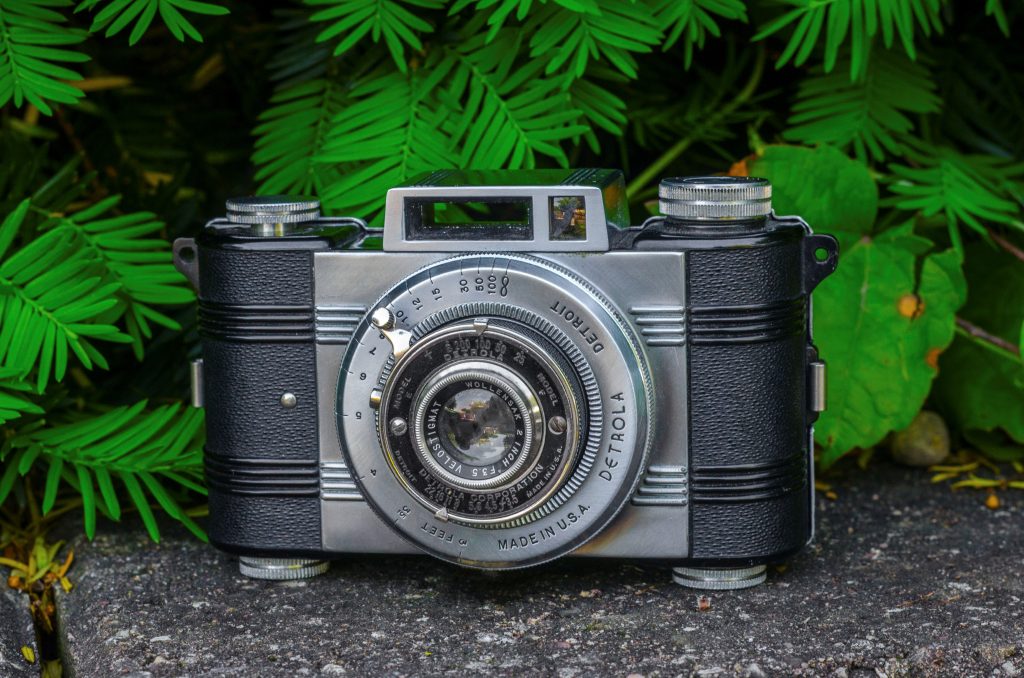 Film Type: 127 roll film (sixteen 4cm x 3cm exposures per roll)
Film Type: 127 roll film (sixteen 4cm x 3cm exposures per roll)
Lens: 2 inch (50.8mm) f/3.5 Wollensak Velostigmat uncoated 3-elements
Focus: 3 feet to Infinity
Viewfinder: Scale Focus Reverse Galilean Rigid Viewfinder
Shutter: Deltex Wollensak Leaf
Speeds: T, B, 1/25 – 1/200 seconds
Exposure Meter: Extinction Meter
Battery: None
Flash Mount: None
Other Features: None
Weight: 480 grams
Manual (Similar Model): https://mikeeckman.com/media/DetrolaHManual.pdf
History
 Detrola was the name of an American company based out of Detroit, Michigan who manufactured radios and record players. The company was founded in 1931 and quickly became one of the largest makers of radios in the United States. Although Detrola sold a variety of different types of radios under their own name, a huge percentage of their manufacturing capacity was dedicated to making models which would be sold under other private brand names. They made Truetone radios for Western Auto, and Silvertone radios for Sears & Roebuck. It is estimated that Detrola radios were sold under as many as 100 different brands, some of which were for very small regional suppliers. Detrola’s advertising in the late 1930s proclaimed them to be the 6th largest maker of radios in the world, whether or not this is true is anyone’s guess.
Detrola was the name of an American company based out of Detroit, Michigan who manufactured radios and record players. The company was founded in 1931 and quickly became one of the largest makers of radios in the United States. Although Detrola sold a variety of different types of radios under their own name, a huge percentage of their manufacturing capacity was dedicated to making models which would be sold under other private brand names. They made Truetone radios for Western Auto, and Silvertone radios for Sears & Roebuck. It is estimated that Detrola radios were sold under as many as 100 different brands, some of which were for very small regional suppliers. Detrola’s advertising in the late 1930s proclaimed them to be the 6th largest maker of radios in the world, whether or not this is true is anyone’s guess.
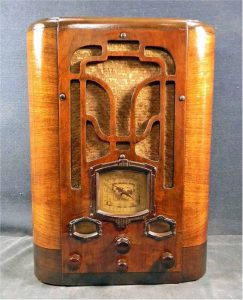
Around 1938, Detrola would follow the lead of the International Radio Corporation (IRC), who was another Michigan based radio maker, and jump into the camera industry by releasing their own line of Detrola cameras. IRC would later change its name to Argus and would have a very successful run in the camera industry, outlasting their radio business.
Detrola’s history as a maker of cameras was far shorter than Argus’, lasting less than 2 years. In the 2 years they made cameras, Detrola really only had two distinct models. The first was a Bakelite bodied scale focus camera which used 127 roll film, and the second was an ambitious 35mm rangefinder called the Detrola 400.
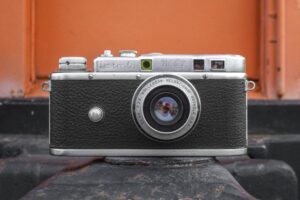
The Detrola 400 was heavily influenced by the Leica III but was built to much cheaper specifications. It featured a stamped metal body and a proprietary 38mm interchangeable lens mount, for which only two lenses were ever made, a 50/2.8 Wollensak Velostigmat triplet, and a 50/3.5 Wollensak triplet. It had a flash hot shoe, a cloth focal plane shutter that could go as high as 1/1500 seconds, and a coupled rangefinder with separate rangefinder and viewfinder windows.
The Detrola 400 sold new for $69.50 which was far cheaper than competing German rangefinders. When adjusted for inflation, $69.50 in 1939 is comparable to $1,233.65 today which put it well out of reach of those who were in the market for a $25 Argus camera. According to one source, Detrola made as many as 250,000 Detrola 400s which seems impossible considering how expensive it would have been at the time, plus very few ever show up for sale on auction sites. A number closer to 2,500 seems more likely based on how rare they are today.
Although far less spectacular of a model, the Bakelite Detrola cameras are the ones most collectors have experience with. There were 10 different sub-models of the Bakelite Detrola, labeled Detrola Models A, B, D, E, G, H, & K. The G, H, and K models also had GW, HW, and KW versions which indicated they had Wollensak lenses. The model in my collection is the Model E which was the highest spec model. Detrolas came equipped with a variety of lenses, shutters, and with or without an extinction meter. The breakdown of what was included in each model is very confusing. I have been able to piece together the following list of features.
Model A – $3.50 – fixed focus single-element meniscus lens with a single speed “Instant” shutter plus T mode
Model B – $9.50 – 2 inch f/7.9 collapsible lens with a single speed “Instant” shutter + B and T modes and an extinction meter for calculating exposure
Model D – $15.00 – 2 inch f/4.5 Detrola Anastigmat lens with variable 1/25 – 1/200 speed shutter, helical focus, and an extinction meter for calculating exposure
Model E – $19.50 – 2 inch f/3.5 Wollensak Velostigmat lens with variable 1/25 – 1/200 speed shutter, helical focus, and an extinction meter for calculating exposure
Model G – $9.95 – 2 inch f/4.5 Detrola Anastigmat lens with variable 1/25 – 1/200 speed shutter
Model H – $12.50 – 2 inch f/4.5 Detrola Anastigmat lens with variable 1/25 – 1/200 speed shutter, finger-tip lens release, and an extinction meter for calculating exposure
Model K – $17.50 – 2 inch f/3.5 Wollensak Velostigmat lens with variable 1/25 – 1/200 speed shutter, finger-tip lens release, and an extinction meter for calculating exposure

A few things about the chart above. For one, the ranking of cameras from most basic to highest spec is not alphabetical. While it would seem that the Model A was the most basic, the Model G was also a pretty low spec camera too. The Model E is a higher speed camera than the G, H, and K models. Also, the prices listed are taken from an unknown magazine ad from the era that can be seen below.
Second, the statement that GW, HW, and KW models came with Wollensak lenses doesn’t seem to be consistent with the name of the models as my Model E has a Wollensak lens too, yet it is not called the EW. Every other example of a Model E that I’ve seen online has the same lens. I have also seen Model K’s with the Wollensak lens, in addition to model KWs with the same lens. Perhaps the inclusion of the letter “W” was a mid-model change to uniquely identify which ones had the Wollensaks, but there is evidence of Wollensak lenses used on Detrolas without a “W” in the model name. It is pretty safe to say that anything with a “W” means it will have a Wollensak lens, but the absence of the “W” does not mean it doesn’t have a Wollensak lens.
It would seem that Detrola would assign a model letter to each model as it became available without any regard to order. Perhaps this is a bit of insight into some chaos that was going on in the company at this time. It would be no surprise that Detrola would discontinue production of all cameras by 1940 and completely disappear by 1948.
I used the 3 advertisements below help to piece together the different models and which features they were equipped with.
Beyond the information that I’ve already shared, little else is known about Detrola. Their history as a maker of cameras lasted barely over a year. I assume that after 1940, like most American companies, they transitioned in some capacity to help with World War II. There is evidence that after the war, they continued to make radios until around 1948, at which time, the company disappeared into bankruptcy. Despite their ambitious designs, they had nowhere near the success as Argus.
Today, Detrola cameras remain popular among collectors due to their unique look and rarity. Although they can be difficult to find, when one does come up for sale, the prices can range anywhere from a little to more than a little. I was happy to find this Model E in such good shape and in mostly working order.
My Thoughts
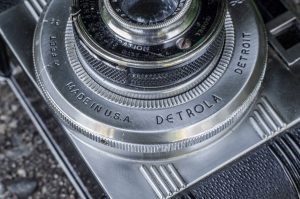
American made cameras from the 30s and 40s didn’t have a lot going for them. They usually had fairly low-spec designs that were sold to the entry level of the market. Many were built with a gratuitous use of Bakelite as opposed to solid metal like the higher end European models. And with a few exceptions, not many American designs are what you would call, ‘easy on the eyes’.
The first time I saw a Detrola camera, I thought it was an extremely attractive camera and I wanted to learn more about them. As I quickly learned (and you now know too by reading this article), Detrolas weren’t around very long. The whole production run lasted barely over a year, so they are quite difficult to find, which is all the more impressive that I came across this example with its original box in the fall of 2015 at a liquidation sale. At the time, this was the first camera in my collection to use 127 film, but I snatched it up anyway, and took it home with the expectation that I would just display it.
I generally try to keep only those cameras which I can shoot, but I figured I could make exceptions. One day, I started talking to Adam Paul from quirkyguywithacamera.blogspot.com, and learned of his ability to “make” 127 film by cutting down 120 film using a rig he created using a TLR camera. This opened the door for me to shoot these kinds of cameras. Before trying out the Detrola, I wanted to clean it. The shutter seemed to work, but only at the same speed no matter what I selected. The lenses were mostly clear, but did have a small amount of haze to them.
I won’t go into much detail about how I repaired the Detrola, as it was incredibly easy. The front lens element unscrews by hand and a few drops of Ronsonol and a wipe down of the glass was all that was needed to restore the camera to full operation.
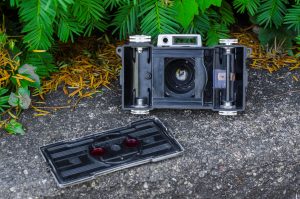
Loading film into the camera is a pretty simple affair, at least as far as 127 cameras go. Like most roll film cameras, you thread a paper leader from the supply roll onto a takeup roll, and load the takeup roll on the left side of the camera. The supply roll goes on the right side.

I don’t know if it is my clumsy fingers, or perhaps these old cameras haven’t aged well, but I always seem to struggle with the spools on 127 cameras. Unlike 120 roll film cameras, 127 spools have these small protrusions that stick out of the center of the spool. In the image to the right, notice how the flange on the 120 spool (left) is flat, and the 127 spool (middle) has a post that sticks out. These posts are on both sides of the 127 spool. Sometimes the post has a slit through the center, and on some, they’re solid. In any case, I seem to always struggle getting these things loaded, especially in the dark. There’s usually a little metal finger that you must pull back to slide the post into a notch in the camera, but I never seem to get it in on the first try. Like I said, the problem is most likely me, but it is worth mentioning if you ever struggle to load in a 127 spool, you’re not alone.
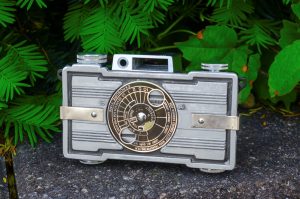
Once the film is loaded, winding the film requires you to rotate the circular exposure disc on the back of the camera to expose the two red windows. Like all other half frame cameras, you must use both red windows to properly advance the film. How it is done is that when advancing the film, the first frame is shot with the number one in the red window on the right. For the second frame, advance the film until the number 1 is in the red window on the left. For the third frame, the number 2 must be in the window to the right, and so on. You have to remember to use every frame number twice. The 16th and final image is shot with the number 8 in the left red window.
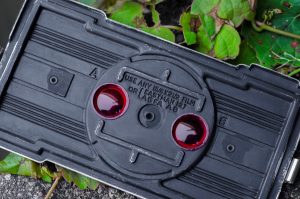
It is advisable to rotate the circular exposure disc back over the red windows when not advancing the film, to protect the film inside of the camera from any errant light rays that may enter through the red windows. Keep in mind that when this camera was made, film was much slower and less sensitive to light leaks. If you re-roll modern film into your Detrola, the chances of a light leak through the red window is greater than it used to be.
It would take me nearly a year to find the time and the right opportunity to load in a roll of 127 film gifted to me by Adam. That opportunity eventually came in September 2016 when I took it with me to a White Sox baseball game.
Despite being a 127 film camera, using it is very much like most other American made cameras of the day. The closest thing in my collection would be the Argus A2F. In fact, other than being a bit shorter and thicker due to the Argus using 35mm film, the two cameras look very similar. The most prominent feature of both cameras is the collapsible lens tube.

I need to say that again…COLLAPSIBLE….LENS….TUBE.
Sadly, after making it almost to the very end of my first roll of film, I realized I had shot every image without extending the lens tube. What a waste! Not only a waste of film custom cut and given to me, but of the images I’ll never see. Discouraged, I put the camera back on the shelf. I should mention that the Detrola models H and K had a feature in which the collapsible lens was held in place by the focus knob. When the focus knob was turned all the way to one side, the tube would lock into position. The lens tube was spring loaded, and turning the knob would release the lock on the lens tube, automatically extending it. Had I been shooting with either of these models, I likely would not have had the problem remembering to extend the lens.
The next opportunity to shoot the Detrola came in the spring of 2017 when I happened upon a large lot of 127 film which motivated me to work through my backlog of 127 cameras including the Foth Derby, Bilora Bella, Acro Model R, and a few others. Remembering my previous folly of never extending the lens tube, I made extra sure to keep the camera extended at all times so I wouldn’t forget.
I found the experience of shooting the Detrola to be uneventful. I don’t mean that in a bad way, but coming up with enough interesting things to talk about is a challenge as it works like so many other basic cameras from the 1930s and 40s.
The viewfinder is extremely basic and offers no focus assistance, parallax correction, or any visible information other than an approximation of the 4cm x 3cm image. The viewfinder is in a portrait orientation when holding the camera horizontally, much like every other half-frame camera out there. You have to remember to turn the camera sideways if you want to compose an image in a landscape orientation. As a result, I shot more images in portrait than I usually would with a full frame camera.
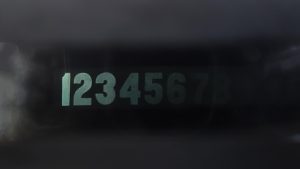
Several Detrola models would have included something called an extinction meter, which was a primitive device in which several numbers (usually 1-9) would be printed on a semi-transparent piece of plastic. As you moved from one number to the next, the plastic would get less and less transparent, to the point where barely any light would pass through the highest number. The image to the right is of an actual extinction meter from an Acro Model R. Had the Detrola’s original meter been included, it would have likely looked very similar.
The idea was that you would look through the extinction meter before shooting your photograph and the highest number you could still see light through, was the number you would use as an index to calculate exposure. The back of the camera has an exposure calculator that would translate the exposure index into an appropriate shutter speed and f/stop. For some reason, almost every Detrola I’ve ever seen is missing the extinction meter, leaving a large rectangular void next to the viewfinder. It seems that whatever material the Detrola’s meter was made of, almost always falls out over time. Even if you are lucky enough to find one with the extinction meter still in tact, they’re very difficult to use and not very reliable.
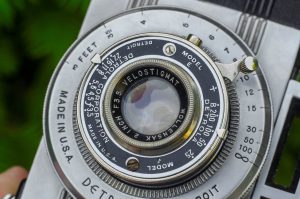
The shutter release is a self-cocking design, and is on the shutter itself. This is both good and bad. Self-cocking shutters eliminate the separate step of having to remember to cock the shutter, but it also makes accidental exposure very easy. Combined with the collapsible lens, you could be firing the shutter accidentally all day long with the camera in a bag, so you have to be careful. If you are trying to intentionally make double exposures, you’ll love this “feature” but otherwise it is something you must pay very close attention to, otherwise you risk ruining your images.
Adjusting focus is very easy as the large knurled ring around the shutter moves the helical in and out. Only the Detrola Models D and E have a helical focus, the rest having unit or front element focus. Helicals are generally regarded as superior methods for changing focus as all lens elements move forward and aft without rotating. When a lens is being built, each element is designed to sharply focus an image in only one orientation. Rotating one or all of the elements can sometimes impact sharpness as aberrations in the glass might impact the light passing through it. On the plus side, Detrola Models H and K had the self-extending lens feature which would have negated any chance at forgetting to extend the lens.
Shutter speeds and aperture f/stops are changed with a simple lever on the top and bottom of the shutter. This be done with the camera lowered from your eye, but that’s pretty typical of the era, so it is neither a pro or a con.
In use, I was neither overwhelmed or underwhelmed in using the Detrola. It is possible that I was so worried about forgetting to keep the lens tube extended that it caused me to overthink my use and stress out about it unnecessarily. Shooting the Detrola was pretty straight forward. I calculated exposure using Sunny 16 and shot the entire roll in well lit sunlight, so I could maximize depth of field with small apertures. I stuck mostly to images shot over 10 feet away, but tried a couple closeups to see what kinds of results I would get.
My Results
For my second roll through the Detrola, I used a roll of hand cut and rolled film provided to me by Adam Paul of Quirky Guy Photo Company. Adam has developed a process that simplifies cutting larger film stock like 120 down to 127 and 828 sizes. He has an article on his website explaining the process for 828 film whcih is basically the same as 127, but a different width.
For this roll, Adam cut down Kodak Ektar 100 and sent it to me wrapped in bathroom tissue and painter’s tape (yes, really) with the instructions to load in subdued light. I followed his instructions and loaded the Detrola and went shooting. One advantage of cutting your own 127 film from 120 is that a roll of 120 is longer than a roll of 127 would have been, so the end result is a slightly longer roll that will give you a few extra exposures than a genuine roll of 127 would have. To accommodate the longer roll of film, Adam reduced the length of the backing paper leader, which is why he gave the specific instructions of loading in subdued light.
So, with a cut down roll of Ektar in my Detrola, I took it with me on a spring weekend and shot some random things around my house.
Before I comment on the images themselves, I should tell you what I had to do to get these images scanned into the computer. I sent the film off to Neil at Willow Photo Labs in Willow Springs, MO. Neil can only develop 127, but can’t scan it as he doesn’t have a scanner for that size. So when I received the negatives back, I realized I had the same problem. I use an Epson V550 flatbed scanner which has film holders for 120 and 35mm only. I was able to scan 828 in my review for the Kodak Flash Bantam since 828 is the same width as 35mm so it fit correctly, but 127 is larger than 35mm and smaller than 120.
There are third party adapters that you can buy that allow you to scan 127 using the 120 holders, but they’re expensive. I thought, a scanner is a scanner, what would happen if I just laid the film directly on the glass and scanned it. Well, without boring you with technical details, there is a reason you need to use dedicated film holders. For one, they keep the film flat and prevent curling, but also, the focal point of a scanner is slightly above the glass surface. Placing something directly on the glass means the negative is below the point at which the scanner will give you the sharpest scan.
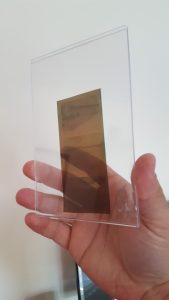
I had to figure out a way to “levitate” the film above the surface of the glass at the exact focal point of the scanner’s lens. I remembered my acrylic photo frames I use to make ground glass for collimating lenses and thought maybe I could sandwich the 127 film in between two pieces of acrylic and put it on the scanner glass and scan it, I tried it, and it worked perfectly! In the image to the right, I am holding a photo frame I bought at Target. The strip of 127 film is sandwiched in between the two pieces of acrylic. The images came out nice and sharp. There was a tad bit of contrast lost as a result of light bouncing around in the acrylic, but it was easily corrected in Photoshop. Another con is that acrylic scratches easy and is a dust magnet, so there’s a much greater change of introducing more debris into your scans, but as long as you keep your work area clean and keep wiping it down, you should be fine.
So with my homemade 127 film holder made out of a $1.99 photo frame from Target, I scanned the roll and was very impressed with the shots. The Detrola uses a Wollensak triplet, which I have experienced in many other cameras like the Bolsey B2, Ciro-Flex, and Clarus MS-35. Despite their modest specs, Wollensak triplets are usually quite good lenses.
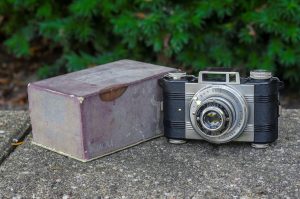
It is not often you get to see the results of an old camera like a Detrola with a modern emulsion like Ektar 100, so even though the images weren’t perfect, these are probably some of the most vibrant and sharpest images ever shot in a Detrola. The uncoated lens had no effect on the color cast of the film. Images were sharp throughout most of the frame, only showing softness at the very edges. Some vignetting was evident at smaller apertures, but nothing that was obtrusive.
There are a variety of light leaks here and there, mostly at the edges where the film was probably exposed to light while still on the spool. In the image of the railroad crossing, there is a large white leak, but that was isolated to just one or two images. Considering the Detrola uses a simple stamped tin back that is held on by spring clips and has no other means of light sealing, I think it performed really well. If I were to use this camera again, I would take better care of the film on the spool and maybe put a couple of strips of electrical tape around the edges of the back of the camera to assure no light leaks in.
With the stress of remembering to keep the lens extended behind me and knowing what the camera is capable of, I see myself shooting this camera again. 127 film is larger than 35mm and provides more detail in the exposed image, giving a mild ‘medium format’ effect for increased detail. I enjoyed my time with the Detrola and combined with its gorgeous looks, I can wholeheartedly recommend one to any collector looking for a nice shelf piece or a 127 camera that is capable of some really nice images.
My Final WordHow these ratings work |
The Detrola was an anomaly from a company that produced cameras for a very short time before disappearing. They resemble many Bakelite bodied 127 and 35mm cameras of the day, but have a gorgeous look to them, including some features like an extinction meter, helical focus, and good Wollensak triplets that make them a step up from just another cheap camera. With fresh 127 film, the Detrola is capable of very sharp images with a subtle vignetting effect that only adds to the vintage appeal of the camera. I didn’t love the experience shooting this camera, but I didn’t hate it either. If you have a chance to add one to your collection, its definitely worth a shot. | ||||||
| Images | Handling | Features | Viewfinder | Feel & Beauty | History | Age | |
| 1 | 0 | 1 | 0 | 2 | 1 | 40% | |
| Bonus | none | ||||||
| Final Score | 7.0 | ||||||
Additional Resources
http://camera-wiki.org/wiki/Detrola
http://www.web4homes.com/cameras/detrola.htm
http://historiccamera.com/cgi-bin/librarium2/pm.cgi?action=app_display&app=datasheet&app_id=2760
http://www.retiredcameras.com/detrola.html
http://www.photoethnography.com/ClassicCameras/index-frameset.html?Detrola.html~mainFrame

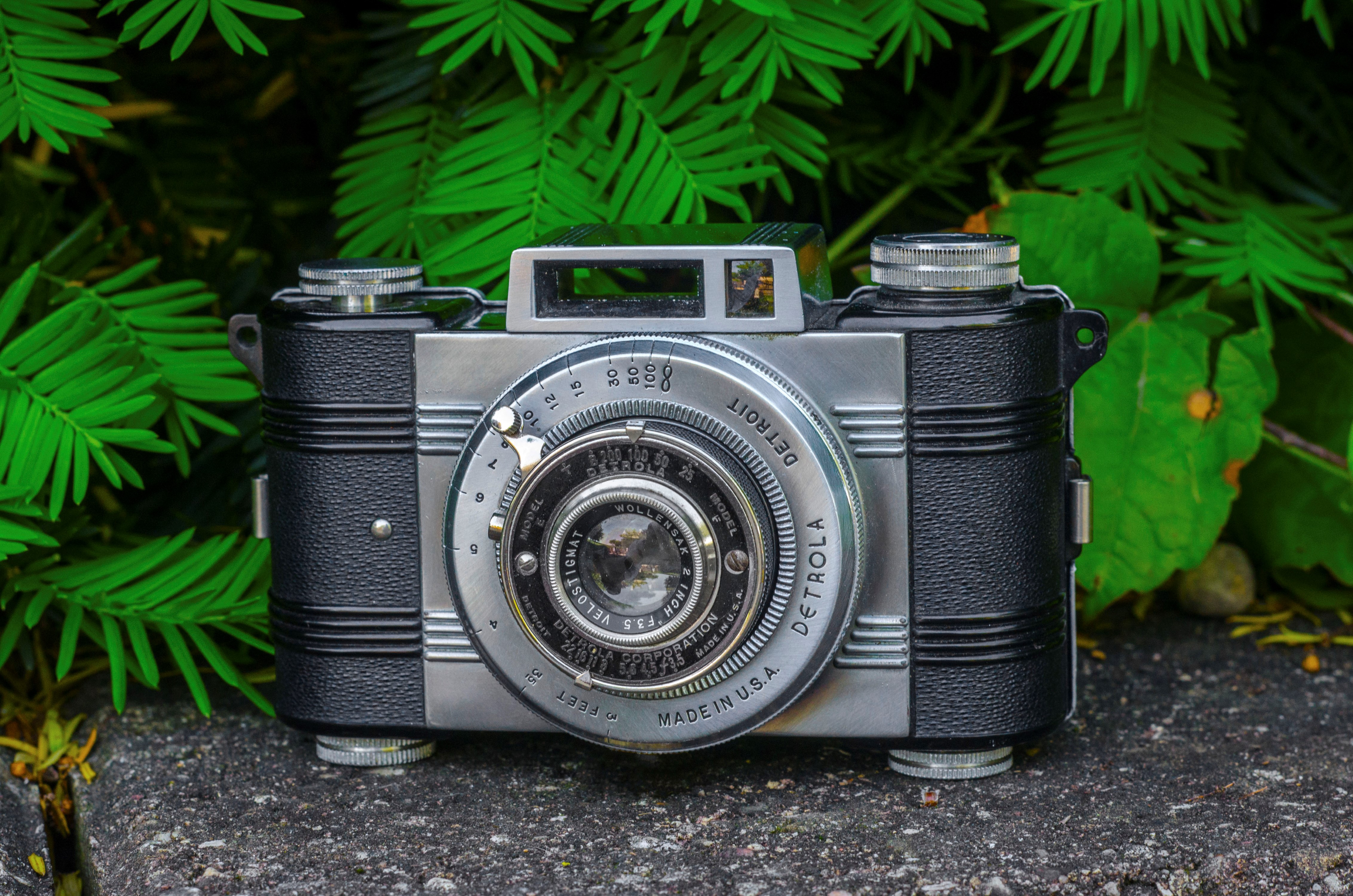
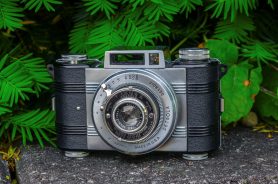
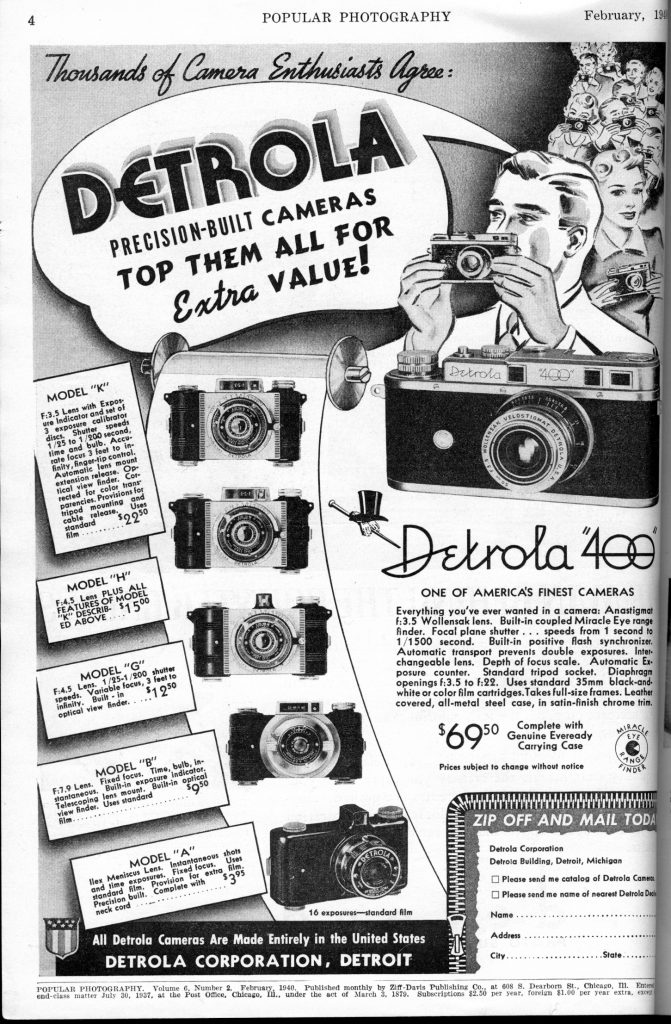











Nice review. I have a Model E on my mantle. Yes, it also has a Wollensak 3.5 lens. And, yes, it’s missing the extinction meter filter material. It is a beautiful camera though. Glad to see you shooting yours.
You’ve done it – you’ve managed to encourage me to give mine another go. Like you, I wasn’t wowed or dismayed by the Detrola experience, but mine seems to have much worse light leakage issues than yours does. I want to love it, and don’t want to dislike it, but so far, I’m ambivalent as I wait to try it once again.
Sadly, I think light leaks are to be expected with a camera like this. The next time I shoot my Detrola, I plan on wrapping the entire perimeter of the film door with electrical tape to help keep them to a minimum!
Yay 127! Thank you for this detailed description.
For what it’s worth, I’ve been using a film holder from Negative Solutions (http://negative-solutions.com/) with my flatbed scanner – it works pretty well (especially with a piece of glass laid on top) and was not expensive.
Thanks for the tip on the film holder. I was aware of custom made options for sale on eBay but never tried them. My cheap picture holder idea only cost me $1.49 to try! 🙂
Thanks for your response! You definitely have me beat on price 🙂
I have a Model E Detrola. It has the extinction meter and the Wollensak lens. I don’t have a box, but I do have a beat up leather case. This camera belonged to my father, and I have never used it.